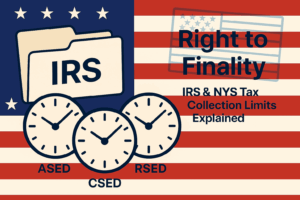
Visual guide showing how the IRS and New York State set limits on tax assessments and collections under the Right to Finality.
🧾 The Right to Finality — How Long Can the IRS or NYS Chase You for Taxes?
Dealing with unpaid taxes can feel like a never-ending battle. Letters keep coming. Interest grows. Eventually, you start to wonder if the IRS or New York State will ever stop.
Fortunately, the IRS Taxpayer Bill of Rights includes the Right to Finality. This ensures you understand:
✔ How long the IRS can audit a return
✔ The deadline to appeal a decision
✔ When the IRS must stop collecting old tax debt
New York State offers similar protections, although its timelines are often even tougher. Therefore, understanding these limits helps you protect your money, your assets, and your peace of mind.
⏳ How Long Can They Audit You?
IRS Audit Deadlines
-
3 years – Standard audit window after a return is filed
-
6 years – If the IRS claims you under-reported income by 25 percent or more
-
Unlimited – If the IRS alleges fraud or the return was never filed
Consequently, filing late or not filing at all keeps that audit clock open indefinitely.
New York State Audit Deadlines
New York generally mirrors the IRS, yet it can be more aggressive.
-
3 years – Normal review period
-
6 years – For substantial understatements
-
Unlimited – If NYS claims fraud or no filing
Because of this, New York taxpayers should, at minimum, keep records for six years.
🧮 The Three Statute Clocks: ASED, RSED & CSED
The IRS operates under three separate time limits, each controlling a different stage of your tax year.
| Term | What It Controls | Standard Period | Extended Periods | When It Stops |
|---|---|---|---|---|
| ASED | The time the IRS can assess more tax | 3 years | 6 years (25 % understatement) or unlimited for fraud or non-filing | If no return filed or fraud alleged |
| CSED | Timeframe the IRS can collect assessed tax | 10 years | Paused for bankruptcy, OIC, appeal, or pending installment request | Tolling events (clock paused) |
| RSED | How long taxpayers can claim refunds | 3 years from filing or 2 years from payment | — | Missed refunds lost permanently |
In short:
-
ASED governs assessment (IRS finding more tax).
-
CSED governs collection (how long they can collect it).
-
RSED governs refunds (your right to claim money back).
Collectively, these three clocks define the entire life cycle of a tax year — from filing, to audit, to collection.
💬 Real Example — Refund Window Closed
We’ve seen how painful these deadlines can be. For instance, one taxpayer lost more than $14,000 in refunds because they missed the filing window. You can read that story in our earlier post, “Don’t Throw Away Free Money — Billions in IRS Refunds Go Unclaimed Every Year.”
This example shows how quickly the refund statute (RSED) can close — and how finality can cut both ways.
⚠️ When the Clock Pauses (Tolling Events)
Certain taxpayer actions temporarily stop the clock. For example:
⏸ Filing an Offer in Compromise
⏸ Requesting an installment agreement
⏸ Filing bankruptcy
⏸ Leaving the U.S. for six months or more
⏸ Submitting appeals or hearings
⏸ Failing to file a required return
As a result, even while you’re trying to resolve your tax debt, your CSED clock may not be running. Unfortunately, the IRS rarely explains this clearly.
💡 Real Case — $601,000 IRS CSED Error
We are currently assisting a client (click to learn more about his story) who owes $601,000 to the IRS. He applied for a payment plan on his own — an action that normally pauses the collection statute for only 30–90 days while the IRS reviews the request.
However, his IRS transcript showed the CSED extended by more than one year — with no explanation.
That was not just an inconvenience — it was a violation of the Right to Finality. The IRS had essentially given itself extra time to collect, which could have cost the taxpayer tens of thousands in added penalties and interest.
Consequently, we immediately:
✅ Disputed the CSED extension
✅ Gathered timeline evidence
✅ Escalated the case to the Taxpayer Advocate Service (TAS)
✅ Requested correction of the statute calculation
✅ Stopped premature enforcement
Even the IRS makes mistakes — and when they do, your rights matter. Our job is to make sure those rights are protected.
⚖️ Why This Right Exists
The Right to Finality exists because tax enforcement should not last forever. Taxpayers deserve closure, financial rehabilitation, and a fresh start.
When used properly, this right can stop collection actions that should have ended long ago. Moreover, it reminds taxpayers that the government must follow the rules too.
✅ The Bottom Line
If you owe taxes to the IRS or NYS:
✔ You have the Right to Finality
✔ Both agencies must follow statute limits
✔ Tolling events can pause — but not erase — the clock
✔ Professional review may reveal expired debts
Therefore, before you assume the IRS can collect forever, get a timeline review. You may be closer to relief than you think.
📞 Protect Your Right to Finality
You don’t have to guess whether the IRS clock is still running.
We calculate your timelines, identify errors, and ensure your rights are enforced.
📞 (718) 938-4601
🗓️ Schedule a confidential consultation: www.wscullycpa.com
Your rights protect you — and we protect your rights.
Want more blog content? Find more here.
Connect with me, everywhere:
Learn about Wayne Scully CPA here
Fill out the form below to connect with us now:

